How to Find Free Camping in the US & Canada
This post may contain affiliate links.
Camping doesn’t need to be expensive. Thankfully there are many places where you can still camp for free—the trick is just knowing how to find it. We’ll show you how!
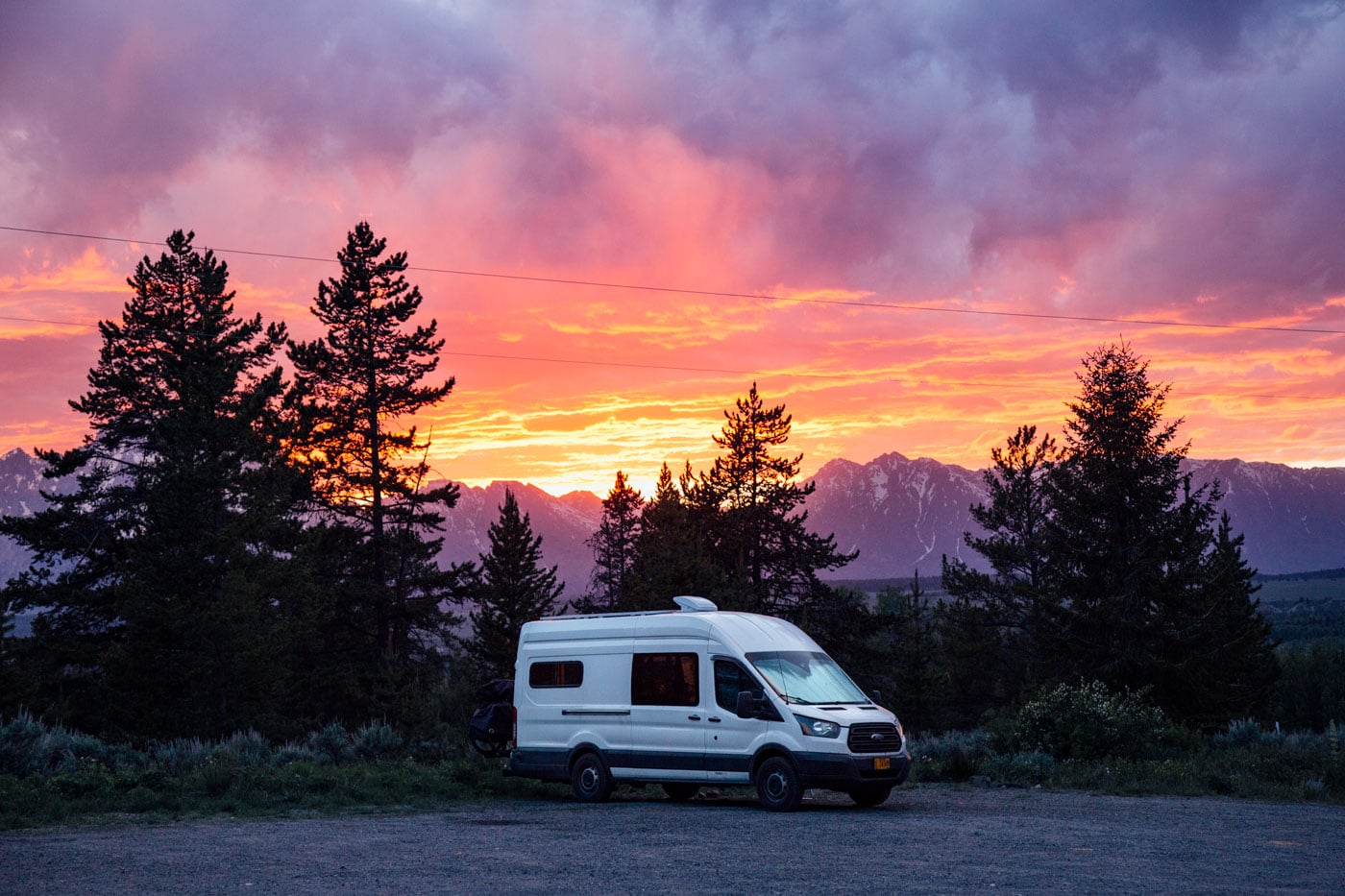
We spent a total of three years living on the road full-time and have traveled all over the US and Canada. One of the most frequent questions we get asked is “How do you afford to pay for campsites every night?”
The simple answer is we don’t.
If we had to pay the usual $20-$30 per night to stay at established campgrounds, we would have gone broke long ago.
Instead, we’ve gotten very good at finding places where you can camp for free. (Yes, such places exist!)
Whether you call it dispersed camping, boondocking, dry camping, or wild camping, the end goal is the same: a place to enjoy the outdoors without having to pay a daily fee.
There are a ton of free camping options out there—you just need to know where to look.
We know what we’re doing now, but when we left on our first road trip, we were completely clueless. On our very first night out, we remember pulling off on the side of the road in Big Sur and frantically searching on our cell phones for the rules of dispersed camping in the National Forest. We couldn’t find anything definitive and in desperation, we ended up nervously sleeping in a pullout. It was awful. The next day, we drove straight to San Francisco to stay with a friend.
Little did we know, we were right next to some of the most epic free camping in the state!
Now that we have a little more experience with free camping, we decided to compile this guide to help anyone who is just starting out.
Below, we’ve outlined everything you need to know about free camping. From what to expect, what to pack, and where you are allowed to camp for free, and most importantly, how to find it.
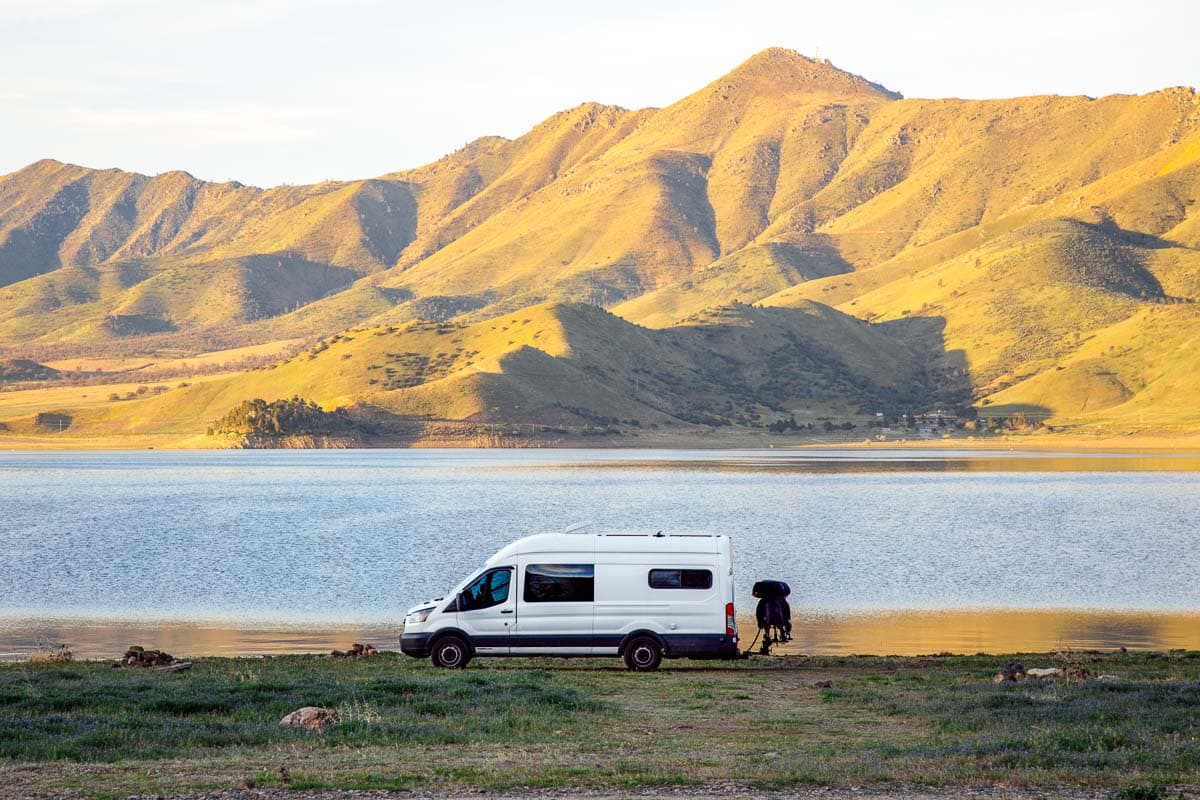
What Is “Free Camping”?
Free camping is exactly what it sounds like: a place you can legally camp without having to pay a fee. Of course, nothing is free and most locations are taxpayer-supported (more on that later), but there is no cost to the individual user on a per-night basis.
There are a bunch of names used to describe different types of free camping. Here are some of the more common ones we’ve seen:
Benefits Of Free Camping
There are a lot of pros when it comes to free camping. Some are obvious (the cost), but there are a few unexpected benefits as well.
It’s free! Obviously, the big draw is the cost. If you’re planning on camping or traveling for an extended period of time, getting good at finding free camping is one of the best ways to bring down your trip’s overall expenses.
Flexibility. It is nice to not be tied down to a specific campground. If you’re exploring or passing through an area with a lot of free dispersed camping it is nice to decide where you want to camp at the end of the day.
Last Minute Trips. Decide you want to go camping on Friday morning before a long weekend? Most established campgrounds will be booked solid months ahead of time. But when you go looking for free dispersed camping, you can almost always find a spot.
Seclusion and solitude. In most established pay campgrounds, you’re packed in like sardines in a tin. You can hear the guy snoring two sites down from you. Free dispersed camping is often in more remote areas, which offers a true sense of peace and calm.
What To Expect
While the exact conditions will depend where you are camping, there are few things you should know about free camping that are relatively universal:
- No showers
- No potable water
- No dump facilities
- No trash cans
- No picnic tables
- No fire rings
- Roads are often rough and unmaintained
- Cell service is hit or miss
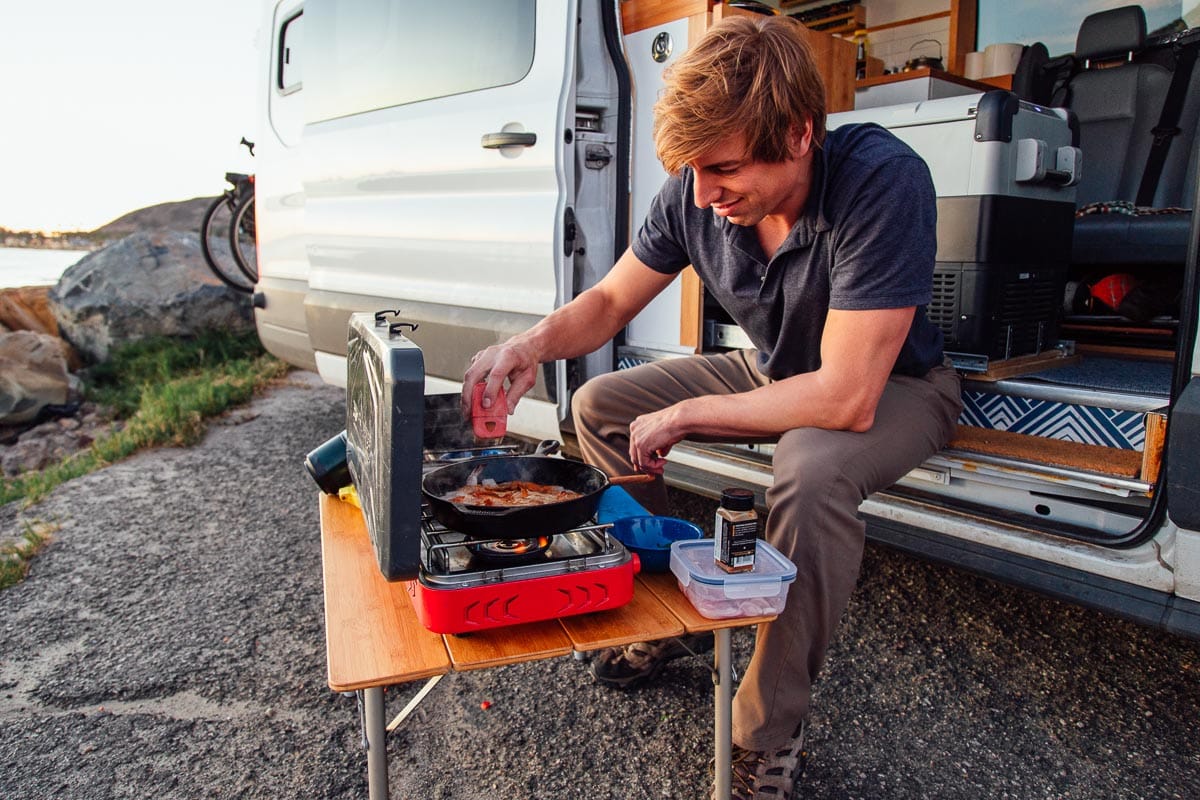
What To Pack For Dispersed Camping Or Boondocking
When choosing a free camping site on public lands like BLM or National Forests, you have to remember that since these areas do not provide any services like bathrooms, potable water, or picnic tables, you’ll need to be completely self-sufficient.
Here is our list of camping essentials while camping outside of established campsites on public land (these items are in addition to our usual camping gear items like a tent, sleeping bags, etc):

Folding Table
Since there will be no provided picnic table, we highly suggest bringing your own folding table. An elevated surface is great for preparing meals, doing dishes, playing cards, etc. It helps to get one that has adjustable legs so you can transition from counter-level height for cooking to a low table for eating.
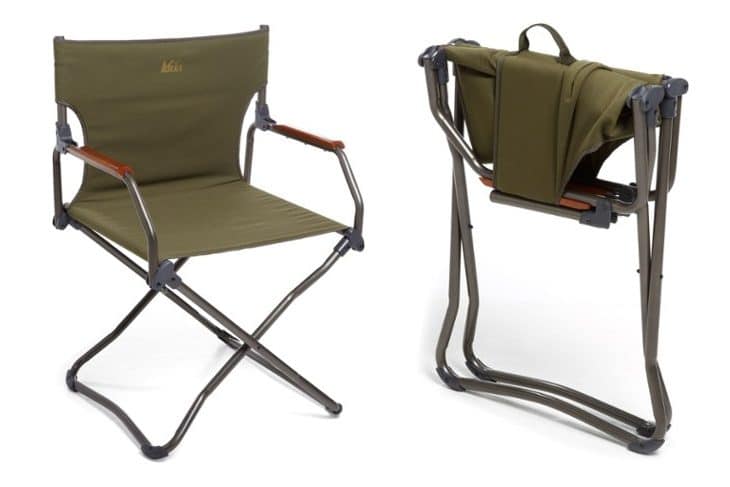
Folding Chairs
Folding chairs are also super helpful to bring along when dispersed camping. Being able to comfortably sit at a campsite can make all the difference.
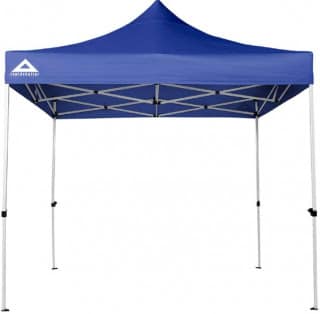
Shade Structure
When you are camping on BLM land, and in some national forest areas, you should be prepared for little to no shade – especially in desert environments. Bringing along a shade structure will give your camp some added comfort during the hot afternoon sun, and doubles as a rain shelter in case the weather goes south.
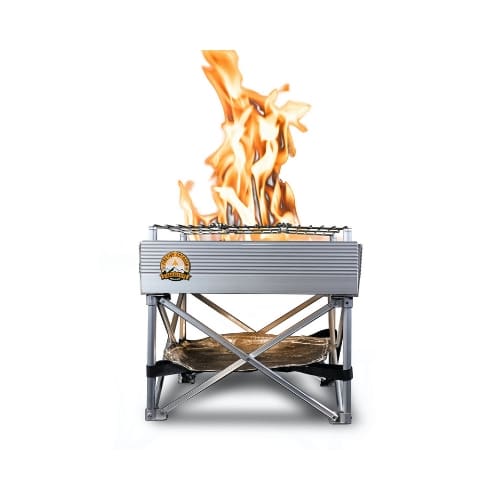
Portable Fire Pit
If the area you are camping in allows campfires (check with the rangers’ or BLM office first!), seek out a pre-existing fire ring location. If you don’t want to search around for a pre-existing fire ring, consider bringing a portable fire pit to lift the campfire off the ground. We use this fire pit, which packs down small when not in use, has a heat shield to protect the ground from scorching, and meets federal regulations for fire pans. It also comes with a grill grate so you can cook meals right over the flames.
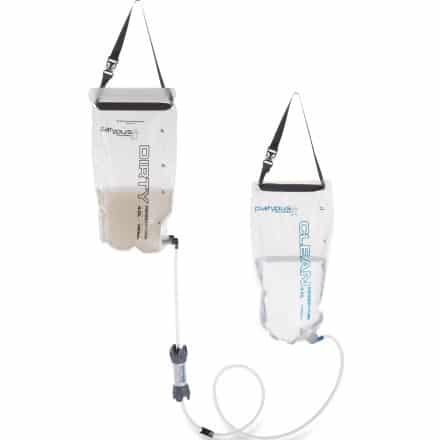
Extra Water (or Filtration System)
Most free camping spots you will encounter have no potable water. You will need to either bring all the water you need for your trip (for drinking, dishwashing, and bathing) or, if there is a lake or stream nearby, you will want to bring a water filtration system. We love our GravityWorks water filter because it’s so easy to use. If you’re packing in all of your water, pick up a few refillable water jugs and fill those up ahead of time
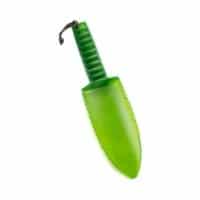
Potty Kit (trowel + TP + trash bag) or WAG bags
Since most (if not all!) free camping areas don’t have bathroom facilities, you’ll need to be prepared to dispose of your waste properly. You’ll need a small trowel to dig a cathole, TP, and a trash bag to pack your TP out. In some sensitive and higher use areas, you’ll need to pack your waste out as well, usually by using a WAG bag. Check with the ranger or BLM office to find out about their specific policies.
Our friend Kristen wrote a great post about doing your business outdoors, which you can check out here.
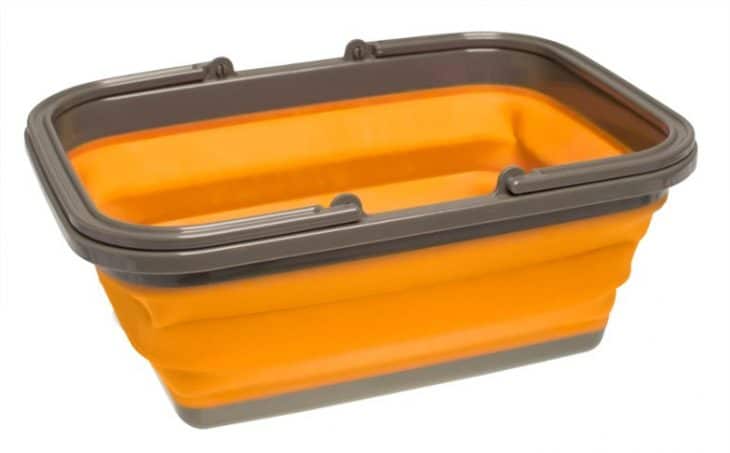
Dishwashing Sink Basin
If your rig doesn’t come equipped with a sink, be sure to bring along a basin to do your dishes in, as well as a sponge & soap. You can learn more about doing dishes while camping here.
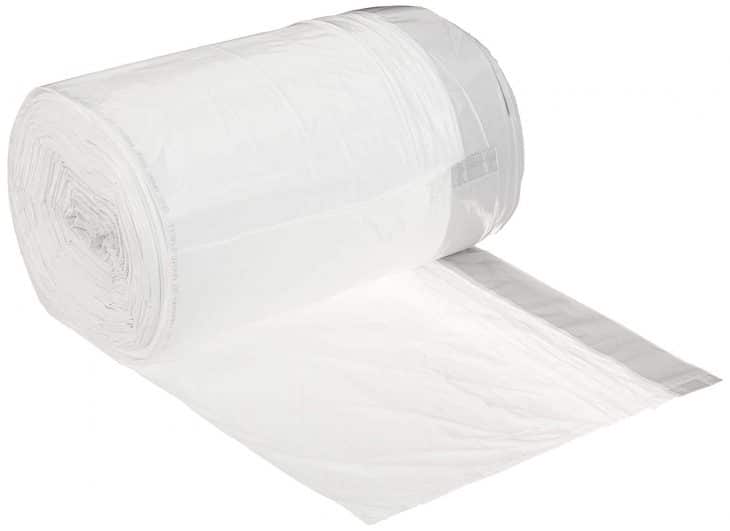
Trash Bags
Whatever you pack in, you’ll need to pack out, so bring along a few trash bags. We always find trash left behind by previous campers, so bonus points to you if you pack an extra trash bag and leave the area even cleaner than you found it!
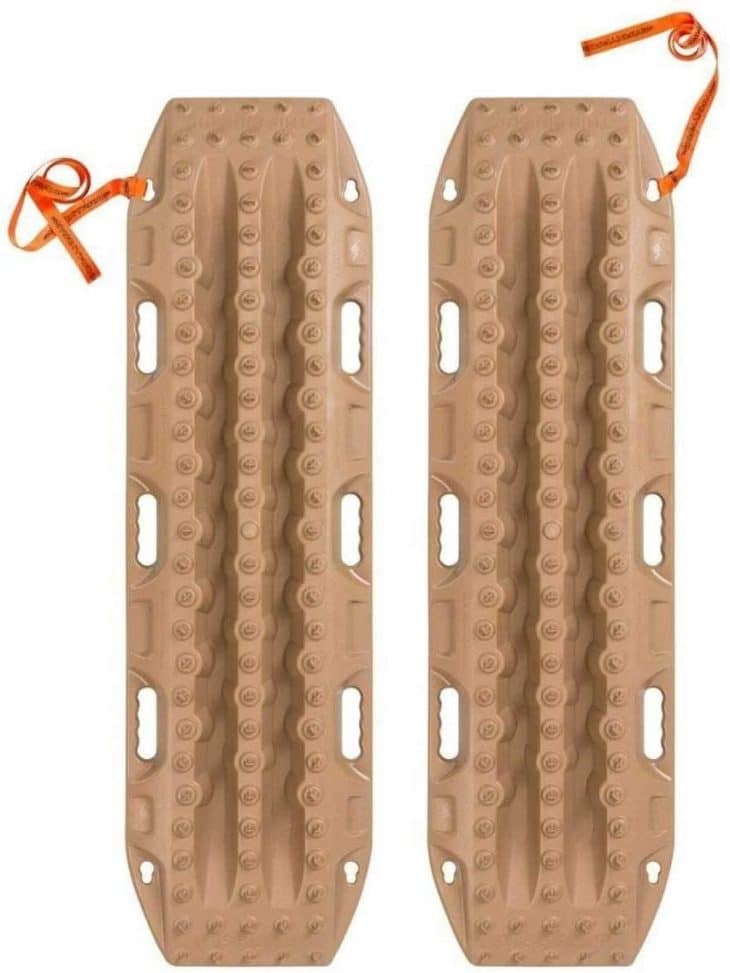
Tire Traction Tracks
Many public land roads are rough and not well maintained, so it might be helpful to pack tire traction tracks, particularly if you’re camping in desert areas. We have gotten our car stuck in the sand before while driving through BLM land, and these would have saved us a lot of headaches!
Leave No Trace Principles For Dispersed Camping
Before we get into where to find free camping, we want to take a quick moment to explain the principles Leave No Trace. These are broad principles that can apply to any type of outdoor recreation but are particularly important to follow when dispersed camping.
Following these Leave No Trace principles is the best way to ensure free camping will be available in the future and to minimize the impact on our public lands. To dive deeper, head over to the LNT website.
Plan Ahead & Prepare: Do a little research ahead of time, bring the right equipment, and be prepared to be completely self-sufficient. Forgetting to bring a trash bag is absolutely no excuse for littering. You should also plan ahead to be aware of area-specific rules regarding campfires, limits on how long you can stay in one area, and how far from the roads you should camp.
Travel and Camp on Durable Surfaces: Do not set up camp on vegetation. Look for barren dirt, rock, or sand to pitch a tent. In the desert environments, become familiar with what cryptobiotic soil (often referred to as “crypto”) looks like and avoid disturbing it.
Dispose of Waste Properly: Pack out all of your waste, including food scraps, toilet paper, etc. In some sensitive and highly used desert areas (like around Moab, UT), you might also need to pack out human waste – check with the ranger station.
Leave What You Find: At a minimum, leave your campsite as you found it. We’d really encourage you to leave your site better than you found it by packing out any additional trash you find.
Minimize Campfire Impacts: Only build a campfire in a pre-established fire ring or bring a portable fire pit with you. Keep your fires low, have water at the ready, and when you’re finished, drown the embers. They should be cool to the touch before you head to bed.
Respect Wildlife: Part of respecting the local wildlife is to ensure your food is properly stored and that animals are not habituated to human food.
Be Considerate of Other Visitors: If you’re reading this article, you probably already have a base level of consideration. And we thank you. But to state the obvious, don’t let your good time ruin somebody else’s. Keep your voices, music, and generators low after hours. Don’t crowd people. Pick up after yourself.
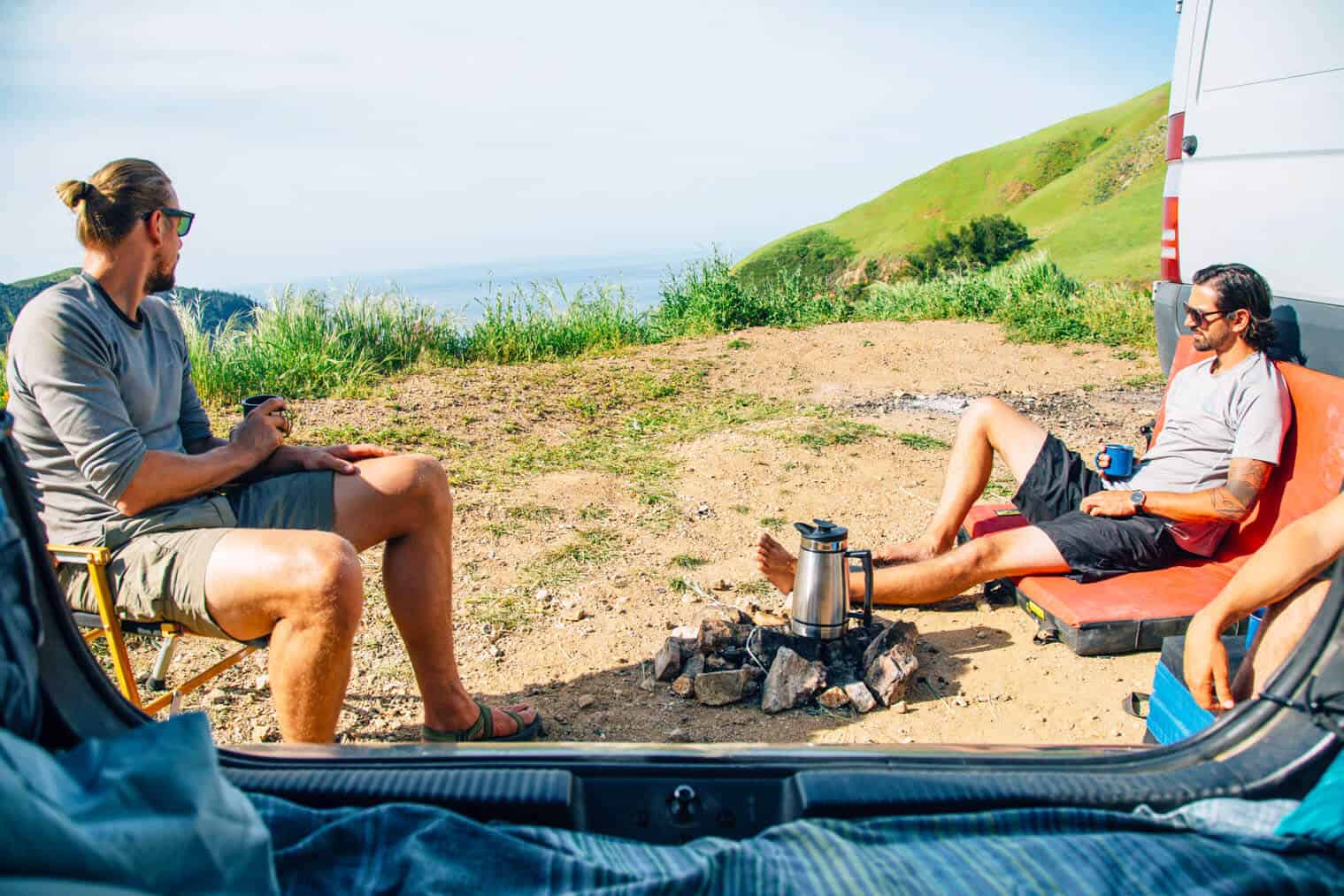
Places Where You Can Find Free Camping
Below, we’ve listed the different types of land where free camping is allowed. Be aware that each type of land is unique and may not be suitable for all forms of camping. Find the right type of land that matches your style of camping.
National forests and grasslands
Typically, you are allowed to camp for free in US National Forests & Grasslands unless otherwise marked. Each national forest has slightly different rules, so check ahead of time, but generally speaking, you are allowed to camp anywhere outside established recreation areas and developed campgrounds.
Who It’s Good For: Tent & car camping, Vans, Trailers, and RVs.
What It’s Like: You have a lot of options when camping in a National Forest. You can find a nice pullover, backpack into the woods to set up camp, or find an attractive spot along a forest service road.
However, you’ll need to be self-sufficient, as there will likely be zero amenities. No picnic table, trash, or restrooms. In some places, you are allowed to have a fire if you obtain a fire permit and there are no fire restrictions in place (these can change frequently, so check with the ranger office).
How to Find It: National Forests are well marked on Google maps, but you can use the National Forest Map Locator or search state by state to find information about the specific jurisdiction you are looking to camp in. Again, the rules are different depending on the area, so check ahead.
You can also use Motor Vehicle Use Maps for the specific National Forest area you’re camping in. These are detailed maps that will show you vehicle use roads, road open/closed dates, and locations of established campgrounds. You can download them (free) from the NF website here. Choose the state & specific National Forest, then scroll down to “Motor Vehicle Use Maps (MVUM)” and follow the directions to download. This way, you don’t have to worry about whether or not you will have cell service while you’re trying to find your campsite! You can also pick them up at the ranger station.
Details:
- Camping must be done outside of developed campgrounds.
- Usually a 14 day limit, sometimes more.
- No amenities – picnic table, trash, or restrooms. Practice Leave No Trace.
- Set up camp 200 feet away from any stream or water source.
** This information does not apply in National Parks–but many National Parks are bordered by National Forests!
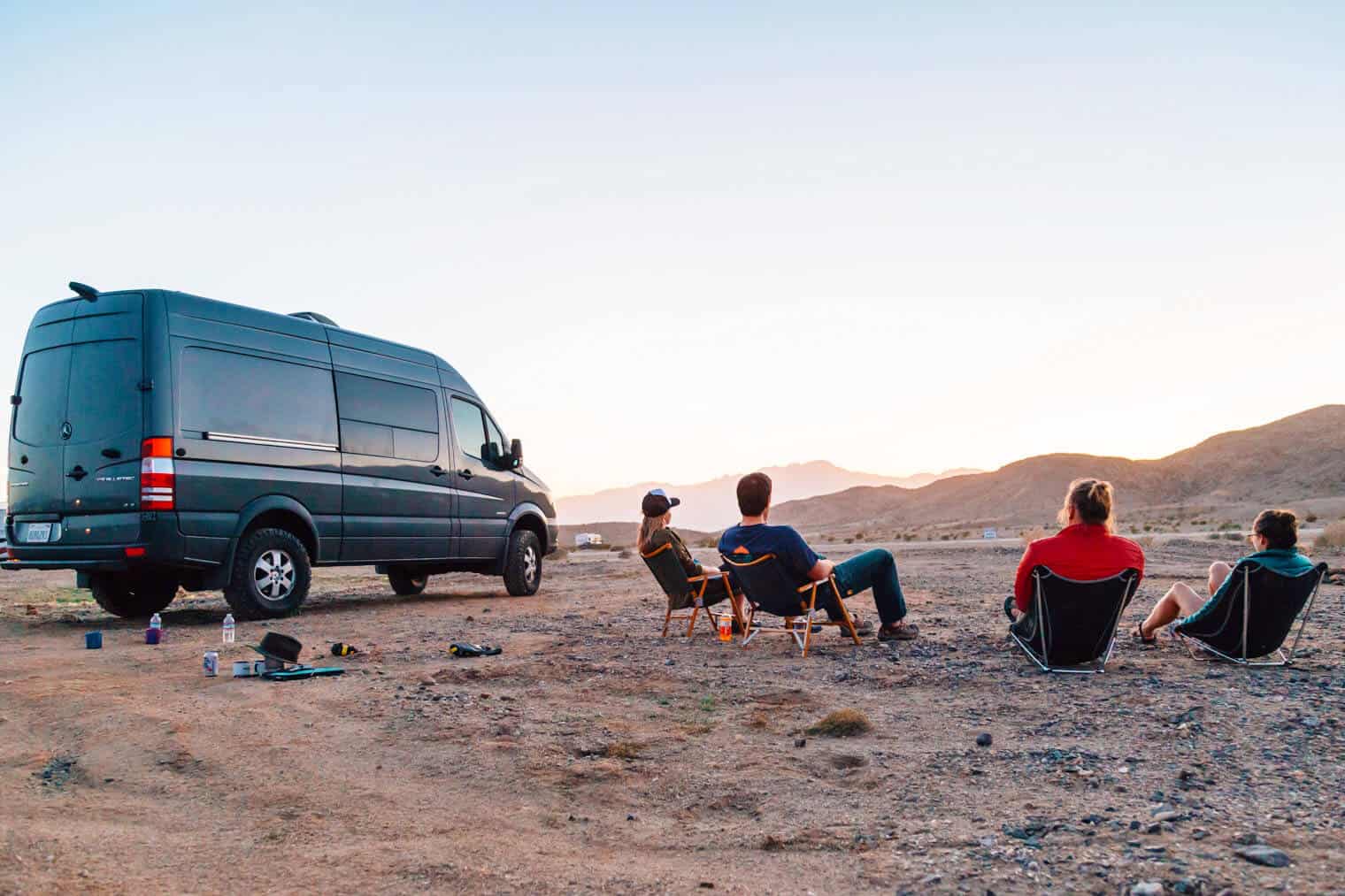
BLM (Bureau of Land Management)
These publicly managed lands are commonly found in the western part of the United States and typically allow free camping outside of developed campgrounds. However, BLM manages a wide range of activities, including cattle grazing rights and mining operations, so they can require a little more research to determine if they’re suitable for camping.
Who It’s Good For: Tent & car camping, Vans, Trailers, and RVs.
What It’s Like: While there is BLM land all over the west, the majority of it covers desert topography. Similar to National Forests, you can stay at pullovers, backpack in a little way, or find a secluded spot along an access road to set up camp. There are also some semi-established unofficial camping areas that are frequented by RVing snowbirds during the winter.
Again, there will be no picnic tables, trash, or restrooms. In some places, you are allowed to have a fire if you obtain a fire permit and there are no fire restrictions in place (these can change frequently, so check with the field office).
How to Find It: BLM lands are not marked on Google Maps, making them a little more difficult to locate. To find BLM land, we use FreeRoam or the Public Lands app or search on the BLM’s interactive map. The BLM map is great because it tells you which field office manages a particular area, so you know who to call with questions. The map also shows which areas are managed by other agencies (ie, national forests, national parks, tribal land, etc).
Details:
- Camping must be done outside of developed campgrounds.
- Usually a 14-day limit, sometimes more.
- No amenities – picnic table, trash, or restrooms. Practice Leave No Trace.
- Set up camp 200 feet away from any stream or water source.
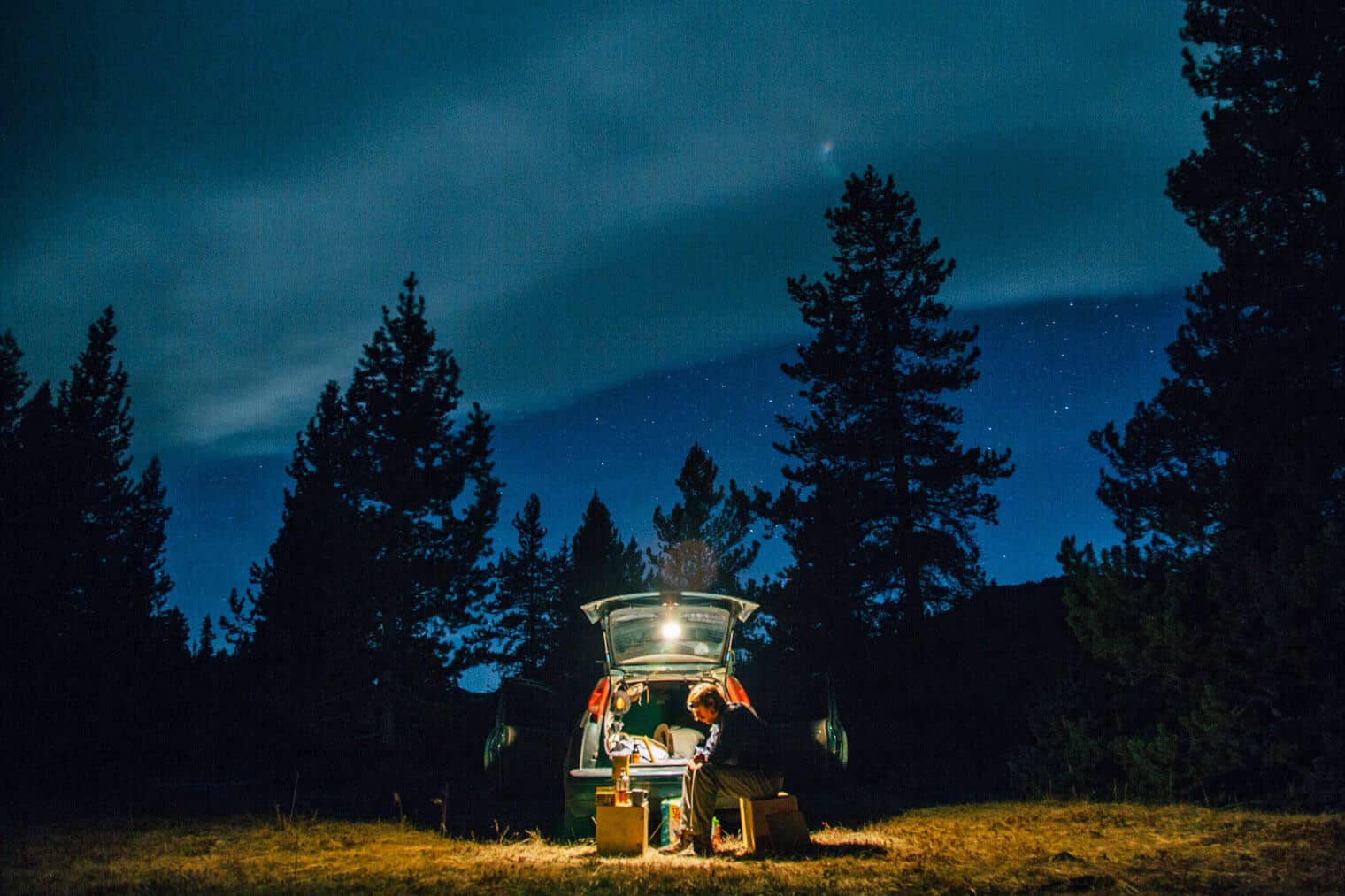
Crown land (Canada)
About 89% of Canada is designated as “Crown Land” and available to Canadian residents for public use. Non-residents can pay for a permit, which varies by province. While you are allowed to camp for free on Crown Land for up to 21 days, there are many areas where camping is not allowed. The reason being that Crown Land is actually divided into different subcategories, which are managed both on the federal and provincial level, with varying levels of restrictions.
All this can be somewhat difficult to understand and navigate, but the sheer amount of Crown Land makes it worthwhile to look into if you are traveling through Canada.
Who It’s Good For: Backpackers, Tent camping, Vans, Trailers, and RVs.
What It’s Like: There’s a lot of Crown Land out there, so your experience will vary greatly on where you’re located. In some provinces like British Columbia, there are primitive campgrounds called Recreation Sites on Crown Land that function like traditional campgrounds, but with fewer amenities. However, much of Crown Land is located in more remote regions of the country, where infrastructure is limited. Because accessing the land can be difficult, many Canadians use public waterways to canoe or kayak in. This is particularly popular in the eastern provinces, like Ontario.
How to Find It: Good question. How to locate Crown Land that is suitable for camping varies from province to province. Some provinces have interactive online maps, some have static .pdf maps, but others don’t have much information at all. Down at the bottom of the article we’ll link to a few resources to help find Crown Land near you.
Details:
- Canadian residents can camp for up to 21 days
- Non-residents can pay for a permit (varies by province)
- Recreation Sites can be accessed by vehicle
- Most Crown Land camping resembles backcountry camping

Walmart
Here we get into the grey zone of what is considered “camping.” While many Walmarts across the country allow RVs, trailers, vans, and other self-contained vehicles to stay overnight in their parking lot, few people would consider this camping. Nevertheless, staying at Walmarts can definitely come in handy at times. Whether you’re trying to pull off an epic travel day and just need a place to sleep for the night, or plan on using Walmart as a staging place in order to stay close to civilization, there are a lot of reasons to spend a night at Wally-World.
Who It’s Good For: Vans, Trailers, and RVs.
What It’s Like: Again, let’s be clear: this isn’t camping. It’s sleeping in your vehicle overnight. Plan on arriving later in the evening and leaving early in the morning. When staying at a Walmart, it’s best to park towards the outer periphery of the parking lot so not to interfere with normal store activities like customer parking and late-night truck deliveries.
Being allowed to stay overnight at Walmart is a very graciously offered privilege, and by no means a right. (From a liability standpoint, it would be way easier for Walmart to prohibit this activity, but they have decided extend a helping hand to travelers.) So, be courteous. The general rule is to keep as low profile as possible. No tents, no chairs, no hibachi grills. Everything must be done within your vehicle.
How to Find It: Not all Walmarts allow overnight parking. This is often the case for Walmarts in major urban centers. In some cases, the store managers have decided against it, in others, local laws prohibit sleeping in your vehicle overnight. Before you decide to stay at a Walmart, check this Walmart No Stay List. You can also call the store and ask to speak with a manager. (We’ve found associates are usually unaware of the policy and will just say no out of over-caution. Speak with a manager.)
Details
- Must remain self-contained within your vehicle.
- Arrive late, leave early.
- Park away from the entrance of the store.
- Bathrooms are available during store hours.
- Need anything? Chances are Walmart has it.
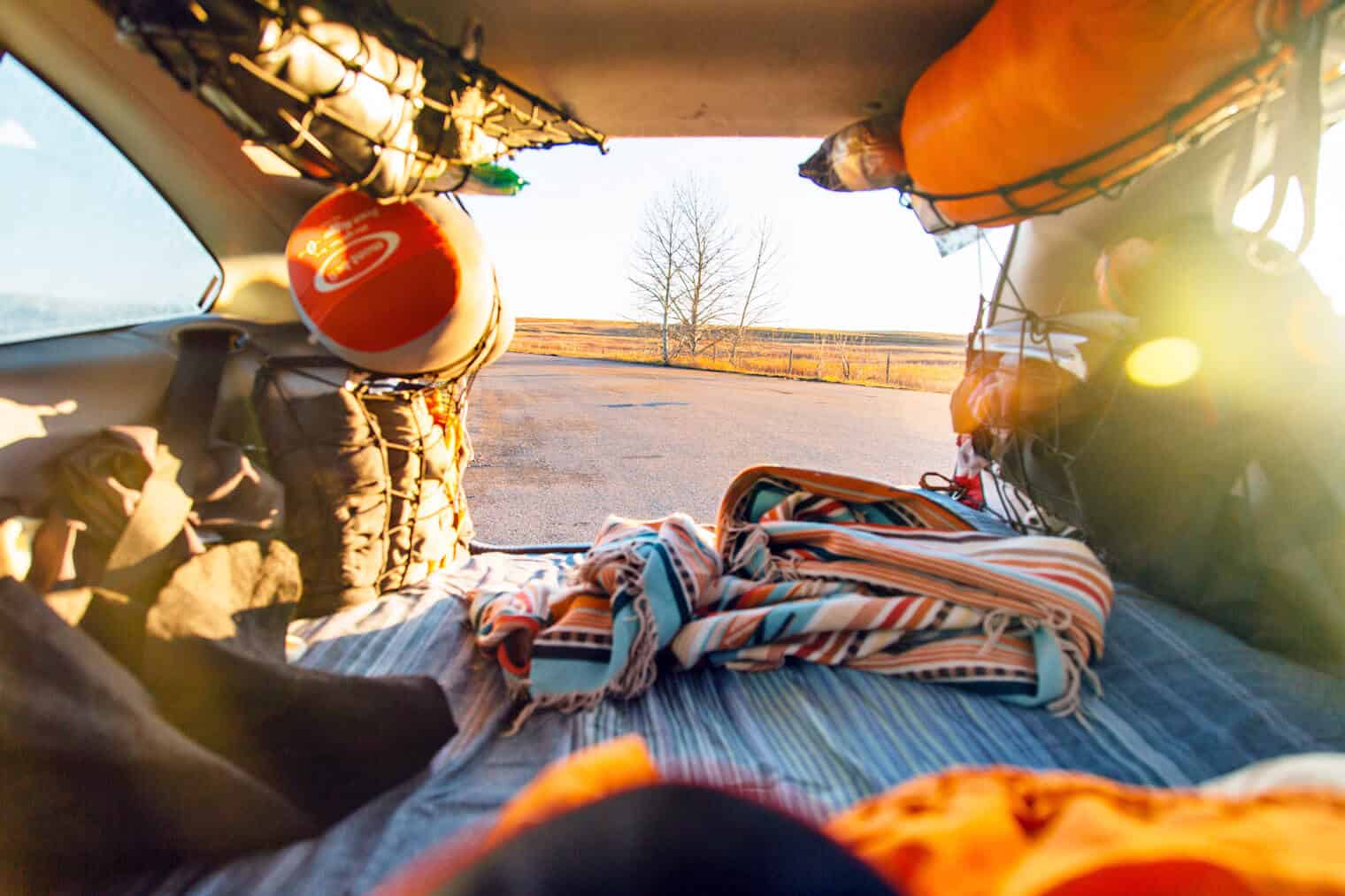
Other non-camping “camping” options
While Walmart is the gold standard for overnight parking / urban stealth camping, there are a few other options that can be worth exploring as well.
Casinos
Many casinos allow overnight parking for RVs, trailers, vans, and other self-contained travelers. The situation will be similar to staying at Walmart. Basically, keep your activities within your vehicle and keep a low profile. You can check out the map locator on CasinoCamper.com to see what casinos allow overnight parking. For more in depth information on camping at casinos, check out this post by Desk to Dirtbag.
Truck Stops
You can hardly drive a hundred miles on a major freeway without seeing a truck stop. While they primarily cater to long-haul truckers, some of them also provide accommodations for RVs, trailers, and vans. In addition to offering fuel, food, and other travel amenities, many of them allow overnight parking. If you’re uncertain, it’s always worth calling the location to find out.
National chain truck stops include:
Rest Stops
Along many US interstate highways, you can find designated rest stops. These locations have been specifically designated for drivers to be able to pull over and rest.
However, finding a rest stop that allows overnight parking can require a lot of digging. Rules differ state by state, county by county, and city by city. Sometimes it can be more trouble than it’s worth, but when it works out, they can be useful in a pinch.
If you’re looking to find a rest stop near you, you can take a look at this list by Interstate Rest Areas.
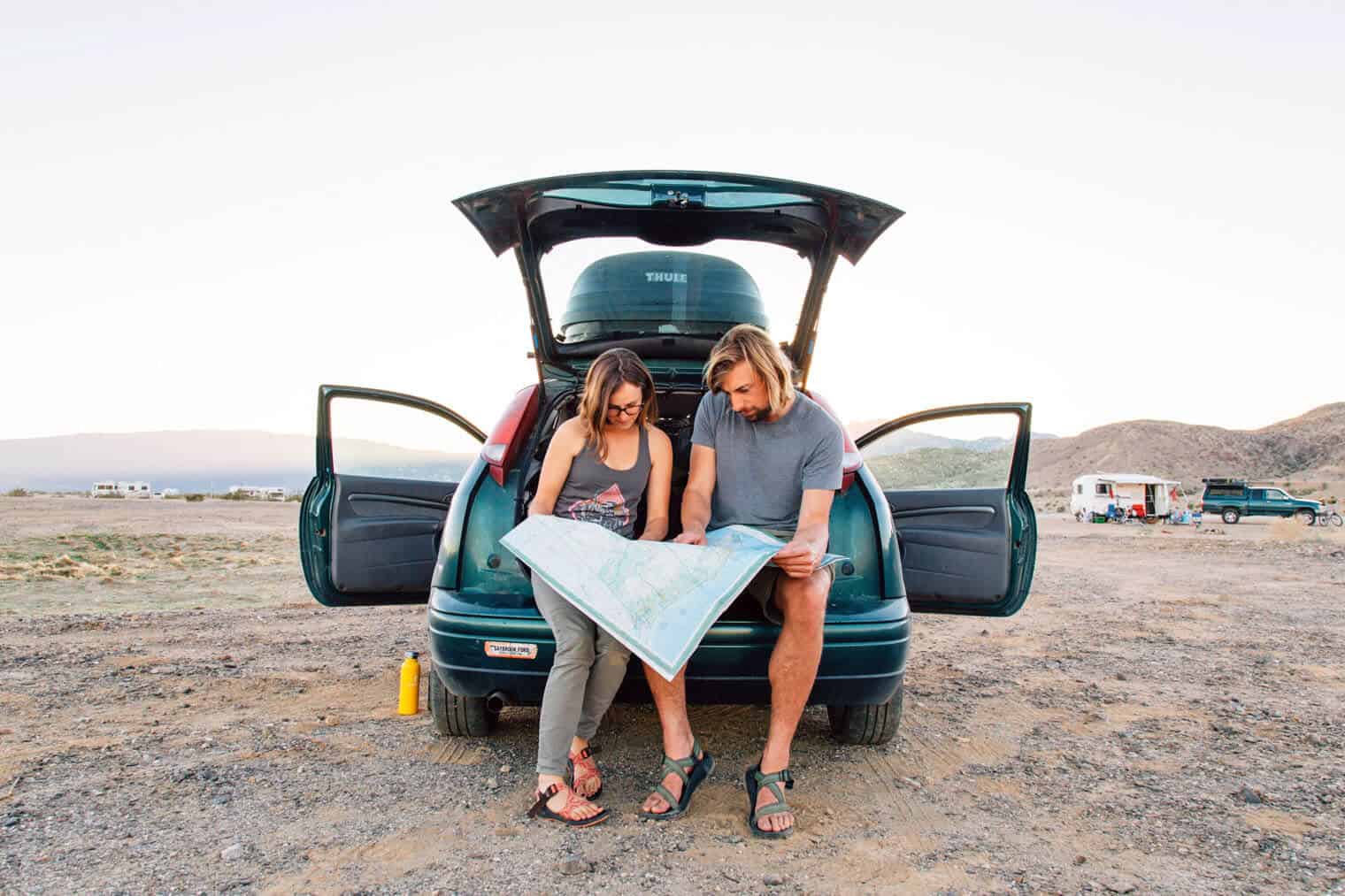
How to find free camping near me
By now you know what to expect, what to bring, and what land allows free camping. Now it’s time to dive into how to find free camping!
By and large, we rely on a few key apps and websites to help us find free campsites.
Below is a collection of up-to-date resources we use to find free campsites when we’re traveling. (Some of them are a bit redundant, so we’ve marked the ones we use most frequently with an asterisk*)
*iOverlander (Free): This app is full of user-submitted campsites as well as other traveler-friendly information like dump stations and water fills. However, since the app relies on users to add and update content, it’s not 100% accurate, so it’s worth doing some additional research once you’ve found a spot you are interested in. But, generally speaking, it’s a great place to start!
The Dyrt PRO: The Dyrt PRO offers some great resources to help you find free camping, including filters to find free campsites, offline National Forest and BLM map overlays, and a trip planner. You can try it for 30 days free by using our code FRESH90 here!
*Free Roam (Free): This desktop and mobile app has some really helpful features. First, you can toggle on National Forest and BLM overlays, making it super easy to find public land. You can also toggle on a satellite map and zoom in to see what the roads/turnouts look like, making it easier to identify if an area might be suitable for boondocking. Second, you can also overlay Motor Vehicle Use Maps, so you don’t have to go searching for the PDFs on the national forest website. Third, you can use the map layers to show cell coverage (by network) and national forest/BLM land. If you create a free account, you can also save sites or your own waypoints, making it great for multi-day planning.
*Campendium (Free): Awesome camping resource that allows you to search for free camping by state. Read reviews, see pictures, and see the campground’s cell coverage. Works great on desktop and mobile, and they also have an app.
US Public Lands App ($2.99): This is a pretty stripped down app that lets you overlay BLM & National Forest land over a satellite image. What we like about this one is you can zoom in on the map to see what the roads/turnouts look like, making it easier to identify if an area might be suitable for boondocking. However, you can get all the features of this app in the free FreeRoam app mentioned above, though the satellite map seems to be a little clearer on the Public Lands app.
Outly (Free or paid): This web and mobile app does a great job showing the boundaries of BLM, National Forests, state land, etc. Additionally, it will show you roads – as well as tell you if it’s a 2WD or 4WD road. If you get the Pro version, you can overlay cell coverage layers and create your own points and routes.
FreeCampsites.net (free): Another great resource that allows you to locate free campgrounds. Read reviews, get GPS coordinates and directions, find out the agency that manages the land. This site is best used on a desktop/laptop, though their map works on mobile as well.
USFS Motor Vehicle Use Maps (free): These are detailed maps that will show you vehicle use roads, road open/closed dates, and locations of established campgrounds. You can download them (free) from the NF website here. Choose the state & specific National Forest, then scroll down to “Motor Vehicle Use Maps (MVUM)” and follow the directions to download or print. This way you don’t have to worry about whether or not you will have cell service while you’re trying to find your campsite! You can also pick them up at the ranger station.
Finding free camping on Canadian Crown Land
- British Columbia: Recreational Sites and Trail Interactive Map
- Ontario: Land Information Ontario Map Locator & Crown Land Use Policy Atlas
- Alberta: Alberta Environment and Parks – Crown Land PDF Maps
- Nova Scotia: Nova Scotia Data Portal – Crown Land Interactive Map
- Saskatchewan: Campgrounds and Recreation Sites – Google Map
- New Brunswick: Crown Land Conservation Map
Paper maps and guidebooks
While you can get a lot of the information you need for free online, it is always useful to have a paper map on hand. Cell service can be notoriously spotty in these remote areas and if Plan A fails, it’s nice to be able to research Plan B on the fly.
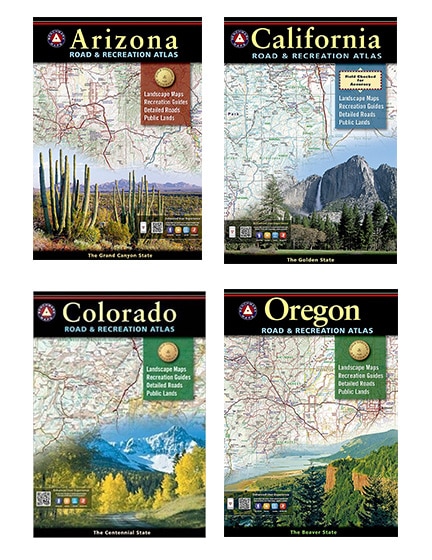
Benchmark Road Map & Recreation Atlas (US)
These large paper atlases offer detailed maps by state. Not only do they outline National Forests, BLM, and other land agencies, but they’re filled with other helpful information like campgrounds, topography, drivable roads (by classification), trailheads, and water sources.
Check price: Amazon
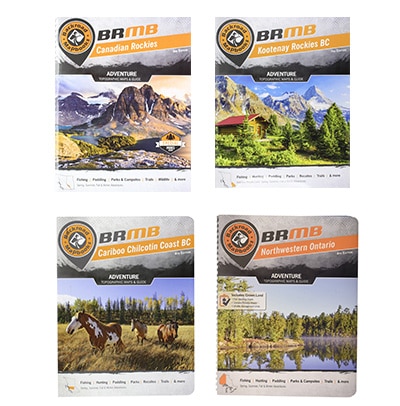
Backroad Mapbooks (Canada)
A collection of regional map books for finding Crown Land, backcountry roads, rec sites, hiking trails, lakes, and hot springs in Canada.
Check price: Amazon
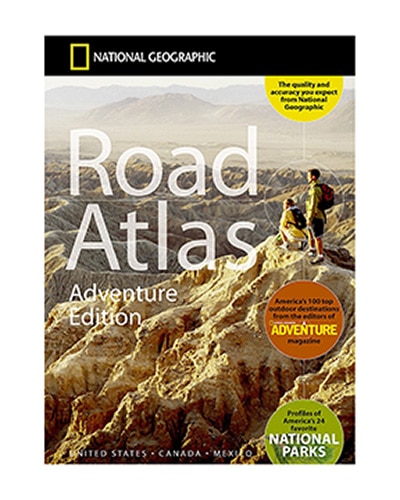
National Geographic Road Atlas – Adventure Edition
This comprehensive atlas covers Canada, United States, and Mexico, with a special focus on outdoor recreational activities. While it won’t give you the same level of detail as a state by state or park by park map would, it will give you a good impression of all of North America.
Check price: Amazon
How do you find free camping?
We hope you found this article on free camping useful and that you feel excited to enjoy some of the great camping opportunities out there.
If you have any special tips or tricks when it comes to finding free camping, please let us know down below in the comments! We’re all about sharing information, so let us know if you think there is anything we should add to this article.
UPDATED: June 2021. Finding free camping has changed a lot since we first wrote this article back in 2016. There are better websites, new apps, and just a lot more information available. This updated post has everything you need to find free camping in the new decade.

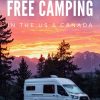

Great information!
Great article! Another option to consider is wineries and farms:
https://harvesthosts.com/
This is fantastic! Thanks for putting all of this information together.
Great article.
If you use Google Earth or desktop software like Garmin’s Basecamp you can add POI (Point of Information) for many of the resources:
http://www.poi-factory.com/poifiles/popular – Rest areas, Walmarts, Cracker Barrell, and truck stops are all potential over night places .
This site will help you convert for different formats including KML for Google Earth –
https://www.gps-data-team.com/convert/
Another resource for RV POI including Escapee boondocking (must be a member and subscribe) here:
http://www.discoveryowners.com/cginfo.htm
Thanks for the additional resources, Scott! The conversion site is especially helpful. We’ve only recently begun using Google Earth but I think it has so much potential.
Thank you for demystifying free camp sites! this is great information!! and i like your delicious recipes too. Keep livin the dream!
This is excellent, thanks so much! I cannot believe how expensive some campsites can be! Sure, it’s nice to have a shower house or laundry facilities every now and then, but I’m planning a 3-6 month road trip next year and no way can I afford $30 a night. This will definitely come in handy.
I can’t believe how expensive some sites are as well. If you stayed at a paid site every night, it could end up costing almost the same as rent for an apartment! It’s definitely nice to have access to showers and the nice restroom facilities that many paid sites provide, but if you’re willing to rough it, you’ll definitely be able to stretch your budget a bit! Enjoy your trip! 🙂
This is a wonderful and informative post! Love all of the photos!!
Growing up my dad was a total off the grid camper when it came to summer vacations, so we got to stay at some pretty rugged, yet jaw dropping gorgeous, out of the way dry camps in a lot of the National Forests in the NW corner of the US. Often times we would have the entire “campground’ area to ourselves. I will always treasure those trips, and have recently been retracing a lot of our camping adventures now, over 20 years later.
Hi! I just discovered your blog and absolutely love it! My boyfriend and I are rebuilding a truck slide in camper and will be traveling for a year or so once it’s finished. Your pictures are amazing, what kind of camera and other equipment do you use? Also are you just naturally gifted or did you take a class to learn how to master photography? Thanks for the inspiration!
-Erin
Hey Erin! Thank you for the kind words 🙂 I picked up a camera back in high school and had intended to go to art school to get an MFA in photography, but went a different route in the end (art school is so expensive!). I did take a few basic photo classes in HS and my first year of college, but I mostly think that the way I got better was by just shooting – a lot, and studying other photographer’s work that I admire (what about the photo do I like/what makes it engaging – composition? Lighting? Use of color, texture, or subject?) I definitely still learn something every day! For equipment, we use a Canon 5D and most recently we picked up a Canon 70D for video, but it is also a great camera for stills as well (and much more affordable and lighter weight)! We have a few different lenses, our most used ones are a 10-18mm and a 24-105mm.
Have a blast on your trip – will you be keeping a blog or an IG for your travels? We’d love to follow along if you do!
-Megan
Thank you so much for replying so fast! I love photography and took high school classes but I always have a hard time getting a crisp clean photo like yours, I will just keep trying and look into the canon 70D, it sounds like that one might be easier to carry. I want to start a blog but I have no idea how to, so there will be lots of researching for me to do, but once I figure it out I’ll let you know! I will keep reading your awesome advice, it is helping me get an idea on what to expect 🙂
-Erin